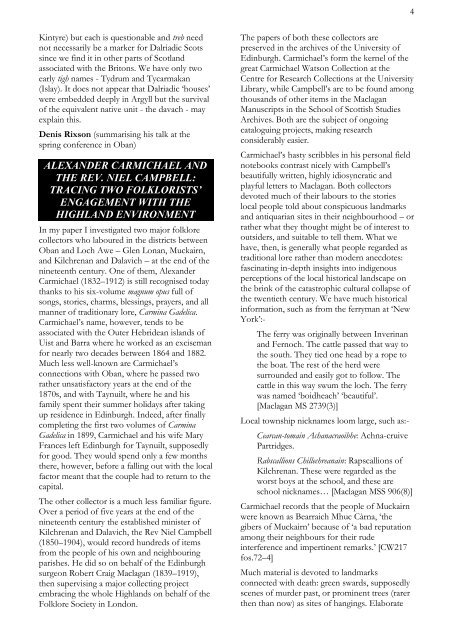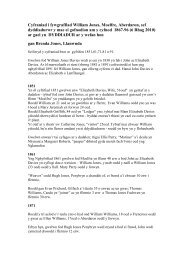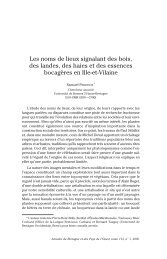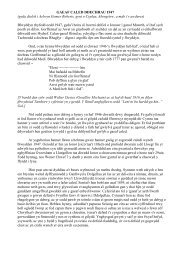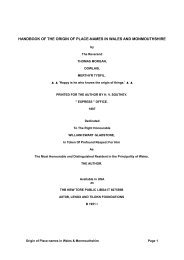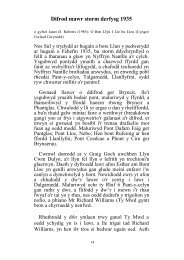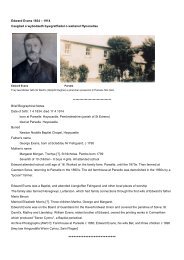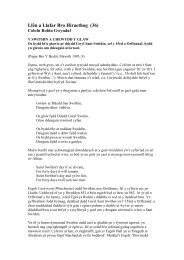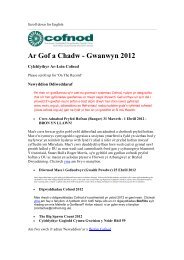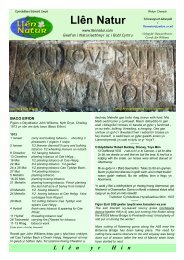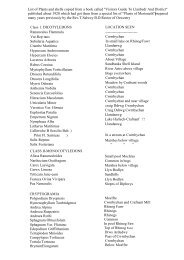new book: 'the place-names of bute'
new book: 'the place-names of bute'
new book: 'the place-names of bute'
You also want an ePaper? Increase the reach of your titles
YUMPU automatically turns print PDFs into web optimized ePapers that Google loves.
Kintyre) but each is questionable and treb need<br />
not necessarily be a marker for Dalriadic Scots<br />
since we find it in other parts <strong>of</strong> Scotland<br />
associated with the Britons. We have only two<br />
early tigh <strong>names</strong> - Tydrum and Tycarmakan<br />
(Islay). It does not appear that Dalriadic ‘houses’<br />
were embedded deeply in Argyll but the survival<br />
<strong>of</strong> the equivalent native unit - the davach - may<br />
explain this.<br />
Denis Rixson (summarising his talk at the<br />
spring conference in Oban)<br />
ALEXANDER CARMICHAEL AND<br />
THE REV. NIEL CAMPBELL:<br />
TRACING TWO FOLKLORISTS’<br />
ENGAGEMENT WITH THE<br />
HIGHLAND ENVIRONMENT<br />
In my paper I investigated two major folklore<br />
collectors who laboured in the districts between<br />
Oban and Loch Awe – Glen Lonan, Muckairn,<br />
and Kilchrenan and Dalavich – at the end <strong>of</strong> the<br />
nineteenth century. One <strong>of</strong> them, Alexander<br />
Carmichael (1832–1912) is still recognised today<br />
thanks to his six-volume magnum opus full <strong>of</strong><br />
songs, stories, charms, blessings, prayers, and all<br />
manner <strong>of</strong> traditionary lore, Carmina Gadelica.<br />
Carmichael’s name, however, tends to be<br />
associated with the Outer Hebridean islands <strong>of</strong><br />
Uist and Barra where he worked as an exciseman<br />
for nearly two decades between 1864 and 1882.<br />
Much less well-known are Carmichael’s<br />
connections with Oban, where he passed two<br />
rather unsatisfactory years at the end <strong>of</strong> the<br />
1870s, and with Taynuilt, where he and his<br />
family spent their summer holidays after taking<br />
up residence in Edinburgh. Indeed, after finally<br />
completing the first two volumes <strong>of</strong> Carmina<br />
Gadelica in 1899, Carmichael and his wife Mary<br />
Frances left Edinburgh for Taynuilt, supposedly<br />
for good. They would spend only a few months<br />
there, however, before a falling out with the local<br />
factor meant that the couple had to return to the<br />
capital.<br />
The other collector is a much less familiar figure.<br />
Over a period <strong>of</strong> five years at the end <strong>of</strong> the<br />
nineteenth century the established minister <strong>of</strong><br />
Kilchrenan and Dalavich, the Rev Niel Campbell<br />
(1850–1904), would record hundreds <strong>of</strong> items<br />
from the people <strong>of</strong> his own and neighbouring<br />
parishes. He did so on behalf <strong>of</strong> the Edinburgh<br />
surgeon Robert Craig Maclagan (1839–1919),<br />
then supervising a major collecting project<br />
embracing the whole Highlands on behalf <strong>of</strong> the<br />
Folklore Society in London.<br />
The papers <strong>of</strong> both these collectors are<br />
preserved in the archives <strong>of</strong> the University <strong>of</strong><br />
Edinburgh. Carmichael’s form the kernel <strong>of</strong> the<br />
great Carmichael Watson Collection at the<br />
Centre for Research Collections at the University<br />
Library, while Campbell’s are to be found among<br />
thousands <strong>of</strong> other items in the Maclagan<br />
Manuscripts in the School <strong>of</strong> Scottish Studies<br />
Archives. Both are the subject <strong>of</strong> ongoing<br />
cataloguing projects, making research<br />
considerably easier.<br />
Carmichael’s hasty scribbles in his personal field<br />
note<strong>book</strong>s contrast nicely with Campbell’s<br />
beautifully written, highly idiosyncratic and<br />
playful letters to Maclagan. Both collectors<br />
devoted much <strong>of</strong> their labours to the stories<br />
local people told about conspicuous landmarks<br />
and antiquarian sites in their neighbourhood – or<br />
rather what they thought might be <strong>of</strong> interest to<br />
outsiders, and suitable to tell them. What we<br />
have, then, is generally what people regarded as<br />
traditional lore rather than modern anecdotes:<br />
fascinating in-depth insights into indigenous<br />
perceptions <strong>of</strong> the local historical landscape on<br />
the brink <strong>of</strong> the catastrophic cultural collapse <strong>of</strong><br />
the twentieth century. We have much historical<br />
information, such as from the ferryman at ‘New<br />
York’:-<br />
The ferry was originally between Inverinan<br />
and Fernoch. The cattle passed that way to<br />
the south. They tied one head by a rope to<br />
the boat. The rest <strong>of</strong> the herd were<br />
surrounded and easily got to follow. The<br />
cattle in this way swum the loch. The ferry<br />
was named ‘boidheach’ ‘beautiful’.<br />
[Maclagan MS 2739(3)]<br />
Local township nick<strong>names</strong> loom large, such as:-<br />
Cearcan-tomain Achanacraoibhe: Achna-cruive<br />
Partridges.<br />
Rabscallions Chillechreanain: Rapscallions <strong>of</strong><br />
Kilchrenan. These were regarded as the<br />
worst boys at the school, and these are<br />
school nick<strong>names</strong>… [Maclagan MSS 906(8)]<br />
Carmichael records that the people <strong>of</strong> Muckairn<br />
were known as Bearraich Mhuc Càrna, ‘the<br />
gibers <strong>of</strong> Muckairn’ because <strong>of</strong> ‘a bad reputation<br />
among their neighbours for their rude<br />
interference and impertinent remarks.’ [CW217<br />
fos.72–4]<br />
Much material is devoted to landmarks<br />
connected with death: green swards, supposedly<br />
scenes <strong>of</strong> murder past, or prominent trees (rarer<br />
then than now) as sites <strong>of</strong> hangings. Elaborate<br />
4


